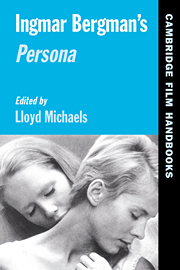Book contents
- Frontmatter
- Contents
- Acknowledgments
- List of Contributors
- Bergman and the Necessary Illusion
- 1 Bergman's Persona through a Native Mindscape
- 2 Persona and the 1960s Art Cinema
- 3 Bergman's Persona
- 4 Scenes from the Class Struggle in Sweden
- 5 Persona and the Seduction of Performance
- 6 Feminist Theory and the Performance of Lesbian Desire in Persona
- Filmography
- Reviews of Persona
- Select Bibliography
- Photographic Credits
- Index
2 - Persona and the 1960s Art Cinema
Published online by Cambridge University Press: 29 January 2010
- Frontmatter
- Contents
- Acknowledgments
- List of Contributors
- Bergman and the Necessary Illusion
- 1 Bergman's Persona through a Native Mindscape
- 2 Persona and the 1960s Art Cinema
- 3 Bergman's Persona
- 4 Scenes from the Class Struggle in Sweden
- 5 Persona and the Seduction of Performance
- 6 Feminist Theory and the Performance of Lesbian Desire in Persona
- Filmography
- Reviews of Persona
- Select Bibliography
- Photographic Credits
- Index
Summary
I vividly recall the first time I saw Persona, after working all night on a film in New York City, traveling to Princeton, New Jersey, to shoot an industrial film, and then, that evening, exhausted after thirty-six hours without sleep, falling into a balcony seat at the Garden Theatre in Princeton, certain that I would be unable to stay awake for the duration of Bergman's latest film. I'd seen nearly all of his earlier films – Wild Strawberries (1957), The Seventh Seal (1956), Summer with Monika (1952), The Magician (1958), and other Bergman classics from the late 1950s and early 1960s – but nothing of his previous work prepared me for the mesmerizing imagery in Persona, arguably Bergman's most accomplished, and certainly his most audacious film. Despite my intense fatigue, I was immediately jolted awake by the opening montage of disparate imagery, by the spare mastery of Bergman's newly economical editorial style, and by Liv Ullmann's hypnotic performance as Elisabet Vogler, an actress who refuses to speak solely as an act of will.
Everything about the film was modern, signaling a break from Bergman's earlier work as a director. Above all, Persona was a plastic, kinetic, wholly cinematic film, responsive to then-current trends in international cinema, effortlessly absorbing the mise-en-scène of Jean-Luc Godard, Alain Resnais, Agnes Varda, and other post-New Wave filmmakers. If The Magician had relied on Max von Sydow's tour de force performance in the title role, Persona was new cinematic territory for Bergman, shorn almost entirely of the theatrical constraints that marked his earlier directorial efforts.
- Type
- Chapter
- Information
- Ingmar Bergman's Persona , pp. 44 - 61Publisher: Cambridge University PressPrint publication year: 1999
- 1
- Cited by



